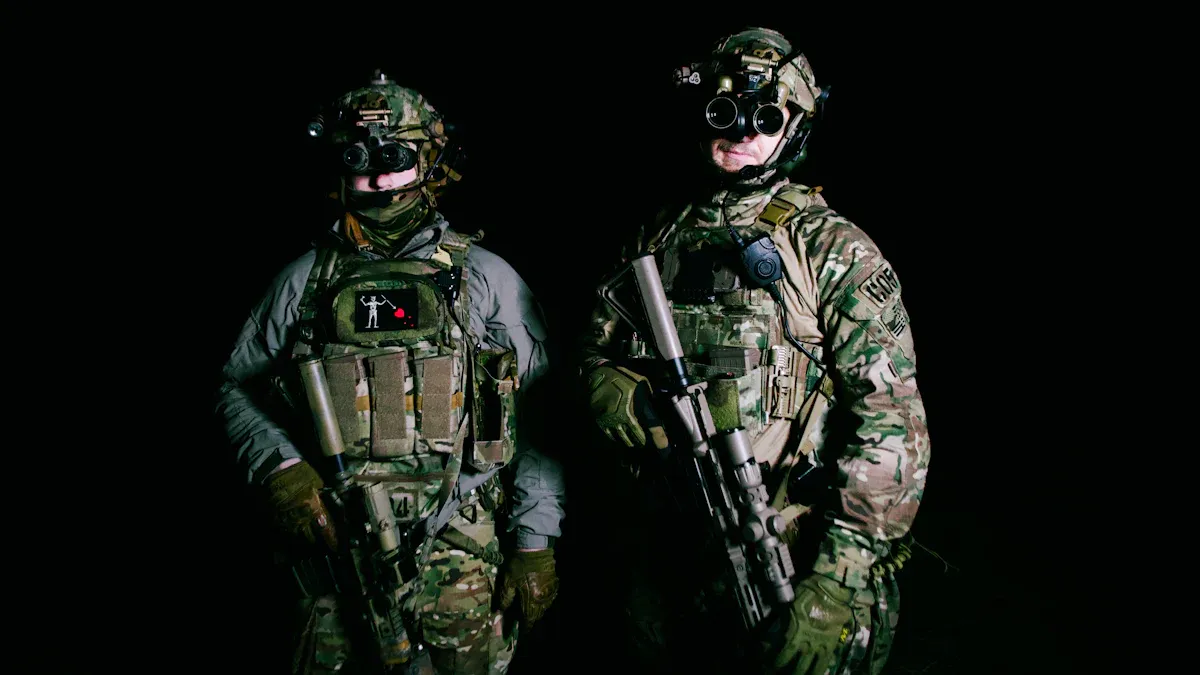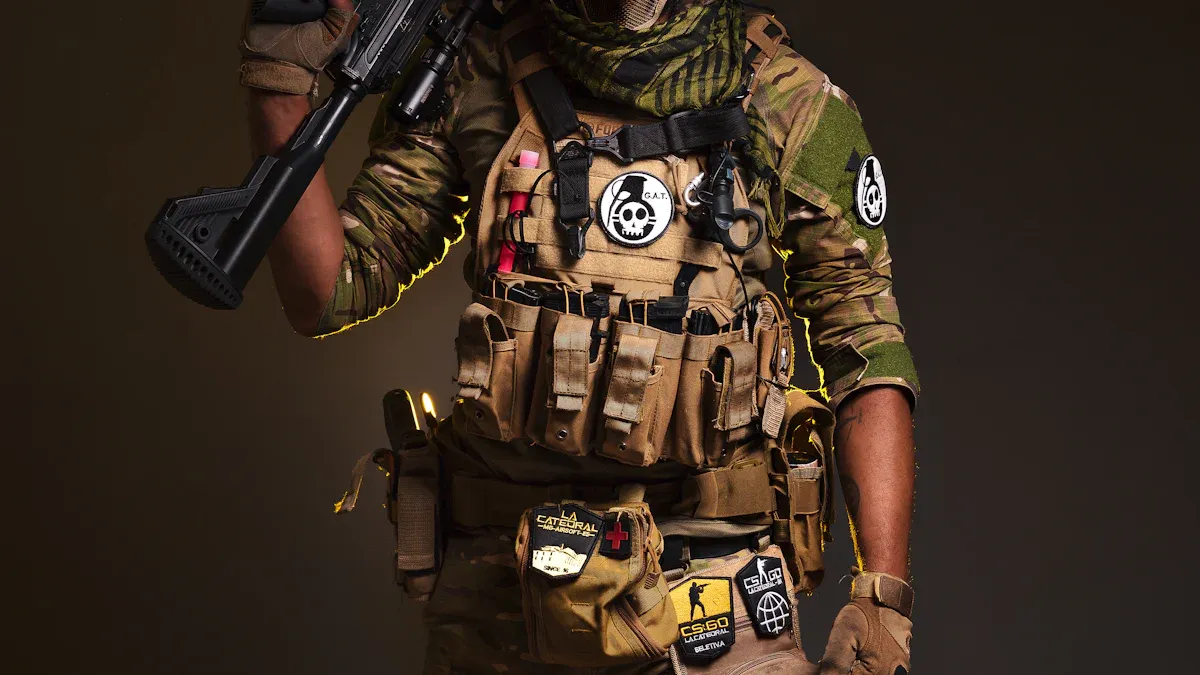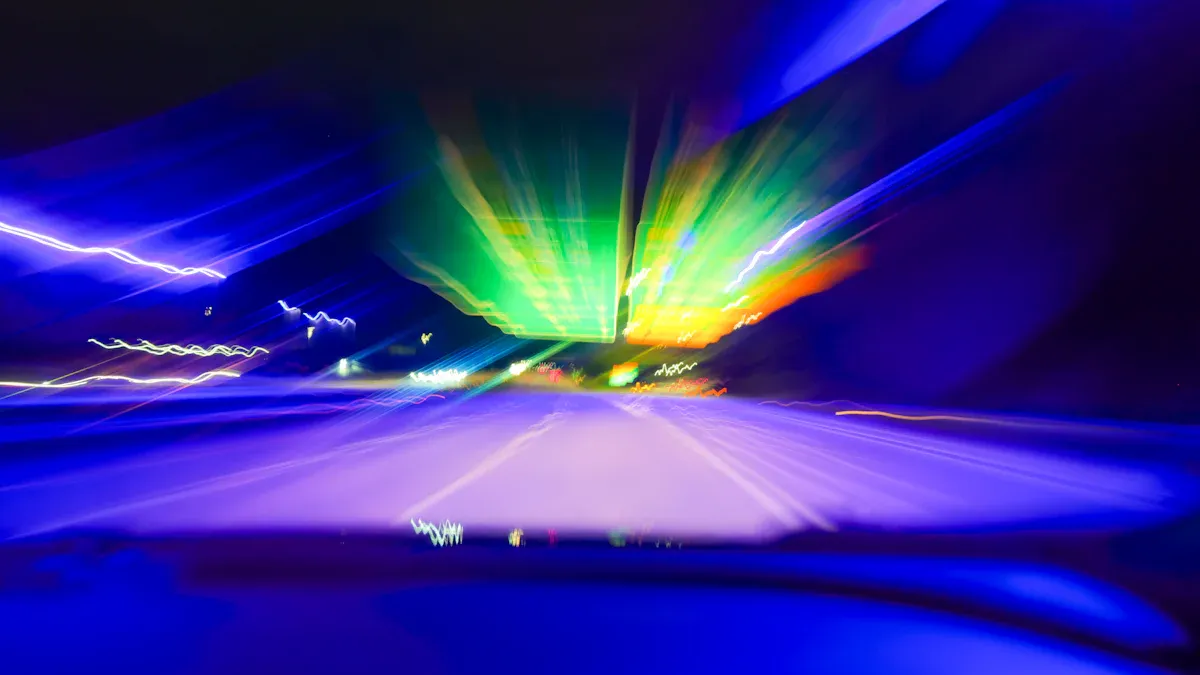Why Tactical and Military Buyers Demand Multi-Color Flashlights

You rely on specialized tools to succeed in challenging environments. Multi-color flashlights let you adapt to changing conditions, whether you move through dense fog, protect your night vision, or need to signal teammates. Different colors serve specific tactical purposes. For example, red preserves your night vision, while amber cuts through smoke. Field reports show that military teams value features like integrated charging and reliable illumination. These flashlights help you stay ready and maintain operational effectiveness in any scenario.
Key Takeaways
Multi-color flashlights enhance adaptability in unpredictable environments. Switching light modes quickly helps maintain control during high-pressure situations.
Different colors serve specific tactical purposes. Red light preserves night vision, green light reduces eye strain, blue light aids in forensic tasks, and amber light improves visibility in adverse weather.
Durability is crucial for tactical flashlights. Military-grade construction ensures they withstand harsh conditions, providing reliable performance when it matters most.
Using multi-color flashlights increases operational effectiveness. They allow for better threat identification, signaling, and mission flexibility, improving overall safety.
Multi-color flashlights offer a significant advantage over single-color models. They provide versatility, enhance situational awareness, and support a wide range of tactical applications.
Operational Advantages

Adaptability
You face unpredictable conditions in tactical and military operations. Multi-color flashlights give you the flexibility to switch between different light modes instantly. This adaptability lets you respond to changing environments, whether you need to preserve your night vision or navigate through smoke. Quick activation of the right color helps you maintain control during high-pressure situations. You can rely on multi-color options to support a wide range of tasks, from stealth movement to emergency signaling. The ability to select the optimal light color increases your operational readiness and mission success.
Effectiveness
You need a tactical flashlight that delivers consistent performance in every scenario. Multi-color flashlights enhance your effectiveness by offering specialized lighting for specific tasks. For example, red-green LED combinations prove superior for Tactical Combat Casualty Care in low-light environments, while blue tactical lights show less effectiveness for color discrimination in medical situations. The following table highlights how different light types impact mission outcomes:
Light Type | Outcome |
|---|---|
Red-Green LED | Superior for Tactical Combat Casualty Care application in low-light environments. |
Blue Tactical Light | Less effective for color discrimination and visual capability in medical scenarios. |
High lumen output ensures you see clearly, even in the darkest conditions. You can trust your tactical flashlight to provide the right illumination for every mission. Multi-color options allow you to adapt your lighting to the task at hand, improving your ability to identify threats, signal teammates, and complete objectives.
Durability
You operate in harsh environments where equipment failure is not an option. Tactical flashlight features must include durability and reliability to withstand extreme conditions. Military-grade construction, water resistance, and shock absorption protect your gear from damage. Compliance with MIL-STD-810G standards ensures your flashlight functions in temperatures from -40°F to 120°F and survives submersion up to 30 meters. The table below outlines key durability requirements for tactical flashlights:
Specification | Requirement |
|---|---|
Waterproof Rating | IPX7 or higher |
Impact Resistance | At least 1.5 meters |
Light Output | 300 to 1000+ lumens |
MIL-STD-810G | Functionality in temperatures from -40°F to 120°F, submersion up to 30 meters |
Military-grade construction
Water resistance
Shock absorption
Compliance with MIL-STD-810G standards
You depend on your flashlight to perform in emergencies and demanding missions. Reliable durability means your tactical flashlight will not let you down when you need it most.
Color Benefits

Red Light
You gain a tactical edge with red light in multi-color flashlights. Red light preserves your night vision, allowing your eyes to adapt quickly when you move from bright areas to darkness. This rapid adaptation helps you maintain situational awareness and reduces the risk of losing sight of your surroundings. Red light also lowers your chances of being detected by adversaries in low-light environments. The beam can distract or mislead detection systems, especially in urban settings, which improves your concealment. You rely on red light for stealth movement, map reading, and covert signaling during missions. These flashlight features make red light essential for military operations where discretion and safety matter most.
Green Light
Green light offers unique advantages in multi-color flashlights. You use green light to illuminate terrain and objects without causing as much eye strain as other colors. Green light is less likely to spook wildlife, making it valuable for reconnaissance and patrols. However, green light systems often produce monochrome images, which can make it harder to identify specific details or distinguish threats from innocents. The table below compares green light systems with color night vision systems in military applications:
Aspect | Green Light Systems | Color Night Vision Systems |
|---|---|---|
Image Type | Monochrome with green tinge | Full color imagery |
Detail Identification | Difficult to isolate details | Enhanced ability to identify details |
Situational Awareness | Limited due to monochrome imagery | Improved situational awareness |
Military Application | Challenges in threat discrimination | Better discrimination between forces |
You benefit from green light when you need to maintain a low profile and avoid detection. Multi-color flashlights with green light help you navigate and observe without drawing attention, supporting mission success in sensitive environments.
Blue Light
Blue light in multi-color flashlights provides critical support for forensic and medical tasks. You use blue light to detect bodily fluids, accelerants, and trace evidence during search and rescue or crime scene investigations. Specialized equipment, such as the MF 470nm Blue Forensic Light System and Nomad® 470nm Blue Forensic Scene Light, helps you visualize evidence in the field. The table below highlights the uses of blue light in tactical operations:
Equipment Name | Uses |
|---|---|
MF 470nm Blue Forensic Light System | Detects serological/body fluids, accelerants, bite marks, bruising, and trace evidence |
Nomad® 470nm Blue Forensic Scene Light | Aids in visualizing forensic evidence in the field |
Blue light tracks blood evidence and body fluids like saliva.
Multiple blue and UV wavelengths enhance detection capabilities.
Crime scene and medicolegal personnel rely on blue light for accurate evidence identification.
You depend on blue light in multi-color flashlights for emergency medical care, forensic analysis, and search operations. These flashlight features improve your ability to locate and document critical evidence, increasing safety and mission effectiveness.
Amber Light
Amber light stands out in multi-color flashlights for its performance in adverse weather. You use amber light to penetrate fog, rain, and snow more effectively than white light. Its longer wavelength scatters less, which reduces glare and enhances visibility. Amber light also makes it easier to distinguish objects and hazards on the road or in the field. The following points summarize the benefits of amber light:
Amber light scatters less, improving visibility in fog, rain, and snow.
It reduces glare, making it easier for you to see in low visibility situations.
Amber fog lights do not blind others and are easier on the eyes.
Amber lights enhance contrast, helping you spot hazards quickly.
They are especially effective in off-road and emergency scenarios.
You rely on amber light in multi-color flashlights to maintain clear vision and safety during challenging weather conditions. These flashlight features support your operational readiness and help you respond effectively in emergencies.
White Light
White light remains a vital component of multi-color flashlights. You use powerful white light to locate and identify threats in low-light situations. High-intensity white light can temporarily disorient adversaries, giving you a tactical advantage. You should use white light sparingly to avoid revealing your position. The Hackathorn/Vickers Flashbulb Technique recommends brief, intermittent use for target identification while maintaining movement. The table below shows how beam pattern and intensity affect situational awareness:
Aspect | Description |
|---|---|
Beam Pattern | Long-range clarity and broad coverage for threat identification |
Situational Awareness | Retains spatial awareness indoors and outdoors, crucial for navigation |
White light is essential for identifying threats and discriminating targets.
Adequate illumination helps you evaluate and engage threats effectively.
Most officer-involved shootings occur in low-light conditions, making visibility critical.
Powerful white lights neutralize the advantage that threats have in darkness.
You depend on white light in multi-color flashlights for maximum lumen output and reliable performance. These flashlight features ensure you stay prepared for any emergency and maintain control in high-pressure situations.
Multi-color flashlights give you the flexibility to choose the right light for every mission. You enhance your safety, effectiveness, and operational success by using the best color for each scenario.
Use Cases for Multi-Color Flashlights
Stealth
You operate in environments where stealth determines your success. Multi-color flashlights let you choose the right beam for covert movement. Red and green lights help you avoid detection during night operations. You can use infrared lighting to signal teammates without revealing your position to adversaries. The table below shows how different lighting types support stealth in military missions:
Type of Lighting | Applications |
|---|---|
Infrared (IR) Lighting | Signaling without revealing position, coordinating movements, identifying vehicles or personnel |
Colored Light Signals | Red: Signals danger or enemy presence; Green: Signals safety or friendly presence; Blue: Special unit marker |
Strobe Lights and Flash Patterns | Coordinating attacks, identifying landing zones, signaling distress |
Tactical Flashlights | Silent commands, distraction, precision signaling |
You rely on these features to move undetected, communicate silently, and maintain control in hostile territory.
Signaling
You need to send clear signals in the field. Multi-color flashlights improve the clarity and reliability of visual signals. You can select a color that stands out against the environment, reducing confusion. The Weltool M7 HCRl flashlight offers a high color rendering index and a homogeneous beam pattern, making your signals easy to see and interpret. You use these flashlights for:
Marking safe zones or danger areas
Coordinating movements with teammates
Sending emergency signals during survival situations
Reading maps or inspecting equipment with accurate color representation
You increase your safety and efficiency by using the right color for each signal.
Mission Flexibility
You face rapidly changing conditions during military operations. Multi-color flashlights give you the flexibility to adapt instantly. You can switch between white, red, green, or mixed beams to match your needs. Some models highlight blood for casualty treatment, offer hands-free mounting, and prevent accidental activation with lock-out modes. The table below outlines features that support mission flexibility:
Feature | Description |
|---|---|
Color Outputs | White, Red, Green, Red+Green mix |
Special Function | Highlights blood during casualty treatment |
Intensity Levels | Momentary and three constant-on levels |
Maximum Output | 425 lumens of white light |
Runtime | 2 hours on high output |
Design | Hands-free with MOLLE TRS Blade Mount |
Lock-out Mode | Prevents accidental illumination |
You stay prepared for emergency and survival scenarios by adapting your flashlight to any situation. These use cases for multi-color flashlights show why you need versatile lighting in every mission.
Multi-Color vs. Single-Color Tactical Flashlight
Limitations of Single-Color
You depend on your tactical flashlight for every mission. Single-color models often restrict your options in the field. When you use only white light, you lose the ability to preserve night vision or signal discreetly. You may struggle to see through fog, smoke, or rain. Single-color tactical flashlights can expose your position and limit your adaptability. You face challenges in medical emergencies, forensic investigations, and stealth operations. The lack of color choices reduces your effectiveness and can compromise your safety.
Tip: Relying on a single-color flashlight may force you to carry extra gear or switch devices, slowing your response time.
Feature | Single-Color Tactical Flashlight | Multi-Color Tactical Flashlight |
|---|---|---|
Night Vision | Poor | Excellent |
Stealth Operations | Limited | Enhanced |
Weather Adaptability | Low | High |
Signaling Options | Minimal | Multiple |
Durability | Standard | Military-grade |
Unique Value of Multi-Color
You gain a tactical advantage with a multi-color tactical flashlight. You switch between red, green, blue, amber, and white beams to match your environment. You preserve night vision, signal teammates, and navigate through harsh weather. Multi-color tactical flashlights offer advanced flashlight features like lock-out modes, hands-free mounting, and high lumen output. You benefit from military-grade durability and reliability, ensuring your gear performs under pressure. You adapt quickly to changing scenarios, whether you need to treat casualties, mark safe zones, or move undetected.
You increase mission success with versatile lighting options.
You reduce risk by choosing the right color for each task.
You improve operational readiness and safety.
Multi-color tactical flashlights set the standard for professional use. You rely on their flexibility, durability, and reliability to meet the demands of any tactical situation.
You choose multi-color flashlights because they deliver unmatched adaptability and safety in tactical environments. Military studies show that these flashlights help you maintain invisibility, enhance situational awareness, and improve accuracy during night operations.
They meet the specific needs of infantry and task forces.
They support daily challenges by improving visibility and reducing risks.
They provide a psychophysical advantage in low-light conditions.
The tactical flashlight market continues to grow as agencies demand reliable, high-performance lighting. You should consider multi-color flashlights as essential gear for every mission.
FAQ
What makes multi-color flashlights better for tactical use?
You gain flexibility with multi-color flashlights. You can switch between colors for different tasks. This adaptability helps you preserve night vision, signal teammates, and see through fog or smoke. You stay ready for any situation.
How do you choose the right color for your mission?
You select the color based on your needs:
Red: Night vision and stealth
Green: Map reading and wildlife observation
Blue: Forensic work
Amber: Fog or smoke
White: Maximum visibility
Tip: Always test your flashlight before deployment.
Are multi-color flashlights more durable than standard models?
You often find multi-color tactical flashlights built to military-grade standards. These models resist water, shock, and extreme temperatures. You can trust them to perform in harsh environments.
Can you use multi-color flashlights for signaling?
You can use different colors to send clear signals. For example, you might use red for danger, green for safety, or blue for special units. You improve communication and reduce confusion during missions.
See Also
Exploring What Defines a Tactical Flashlight Today
A Complete Guide to Selecting Color Flashlights for Outdoors
Evaluating Green Versus White Flashlights for Hunting Purposes
